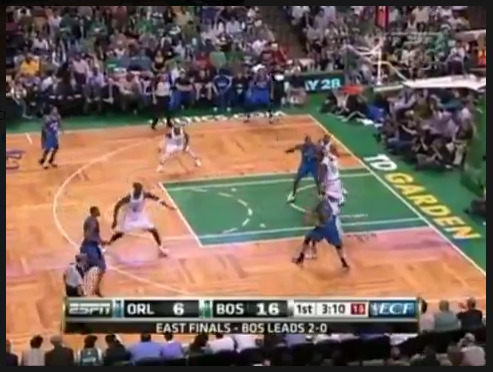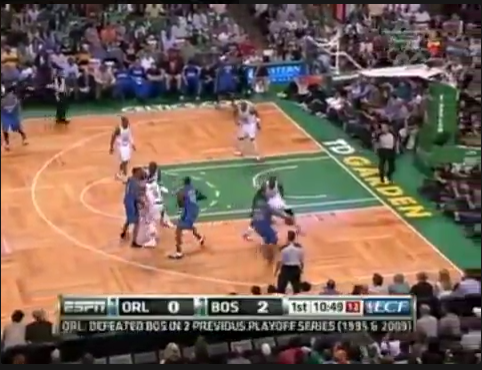The NBA is a Copycat League: Introducing the Ever-Changing Meta

Whenever playing competitive games such as Overwatch or CS-GO, rules and game mechanic balancing give certain character or gun selections preference over others. These standard choices and styles are considered “meta” because, as a result of the rules and styles within the game, they represent the most likely course to victory.
In the NBA, rules and effectiveness are not tinkered with through patch updates, but through the evolution of restrictions instituted by the league, player personnel and offensive/defensive tactics developed by teams. Ripple effects of inside and outside influences have morphed the standard customs and tactics of play, even if they’ve never been described as meta. Changes by the league—outlawing of hand checking, illegal defenses and defensive violation calls—have shifted the meta offense from running through big men in the post to high pick-and-roll and perimeter-oriented guard play, leading to an explosion in three-point tries. The rise of analytics have progressed different ideas about the most effective ways to play, thus further shifting the meta.
The NBA is a copycat league; teams and coaches copy ideas, schemes and team construction from each other.
Essentially, creative coaches test new styles of play that (sometimes) prove incredibly effective. Teams employ non-meta offensive tactics and defensive schemes that outperform the meta, and thus, other teams copy them. Then the meta shifts. Houston Rockets general manager Daryl Morey described this exact phenomenon in 2013, per Grantland.com’s Zach Lowe: “A lot of the defensive strategies you see now are a natural evolution from rule changes. First the defense evolved by overloading the strong side, and now the offenses are evolving to beat that.”
The meta shifts again once offenses (or defenses) acclimate to the new schemes. There is almost always a reverse wave within the meta. Organizations are creative and there will be holes in any adjustment because there are ten imperfect players on the court at a given time.
In the late 2000s, then-Chicago Bulls head coach Tom Thibodeau created a defensive scheme predicated upon overloading the strong side of the floor and the painted area, forcing opposing teams to rely on passing around the perimeter to beat it. As Lowe described it, “Coaches want players away from the ball ‘to 2.9’ on defense…Stay in the paint for as long as possible without committing a defensive three-second violation.”
In the above clip from 2010, the Boston Celtics utilizes Thibodeau’s defensive scheme to disrupt the Orlando Magic’s offense. At the start of the possession, Magic swingman Vince Carter (he played for Orlando!?!?) drives right off a pick-and-roll set the top of the key. On the weak side of the floor, Paul Pierce slides to the paint in order impede Dwight Howard, who’s serving as the roll man.

He leaves his offensive assignment open in the corner, understanding that he or teammate Rajon Rondo will be able to recover in the event of a cross-court pass. Orlando’s inability to beat the defensive motion and find the opening (shown in the still frame above) causes a turnover.
Here, Orlando runs a double high screen-and-roll to the right-hand side of the floor in order to find space in the paint for Howard. Point guard Jameer Nelson tries to force a soft pass over his defender, but Pierce, who left his man on the weak side, executing the same defensive rotation he did in the first play, picks it off.
However, in this second clip, we can see potential holes in the scheme.

Prior to Pierce’s shift, Nelson could find a small opening for a bounce pass to Howard, but the rotation forces a greater level of precision from the passer.
At the top left of the frame, Matt Barnes is sitting on the three-point arc. In the center of the court above the free-throw line, Rashard Lewis stands motionless, watching the pick-and-roll action. If Barnes was enough of a shooting threat or Lewis was able to float behind the arc, they could have served as auxiliary options for Nelson to rotate the ball to an open shooter.
The 2010 Celtics became a model for defensive rotations around the league, and Thibodeau’s schemes quickly changed the meta. The new goal? Forcing an offense to abandon primary scoring options and move the ball in order to beat it. The reverse wave was manifested by teams like 2010-11 Miami Heat, who exposed the holes thanks to intelligent passers and cutters in Lebron James and Dwyane Wade.
Playing the Celtics in Game 1 of the 2011 Eastern Conference Semifinals, the Heat were set on attacking the Celtics’ rotation scheme.
The first adjustment to Orlando’s strategy from one year earlier was Miami’s use of the high screen-and-roll action. Instead of initiating the play inside the three-point arc, Dwyane Wade called for Chris Bosh to set his screen further out, creating more ground for the weak-side rotation to cover. Glen Davis, guarding Udonis Haslem, rotated from the weak side to stop the drive by Wade or potential roll by Bosh, while Pierce rotated into the paint to cover Davis’ man. However, while Orlando had its shooter stay in the corner, LeBron James decided to cut to the basket, which opened up an outlet pass for Wade. The cut was made possible by Davis’ early rotation and the screen set on Pierce by Haslem: Pierce, manning the middle of the paint, was unable to reach James because Haslem was aware only one defender was in the area to cover both him and James.
Rule changes and innovation can change the meta across the league, but personnel also functions as a frequent factor. That version of the Heat used a “pace and space” approach, surrounding playmakers with cutting and shooting to confuse the defense. This offensive scheme was also predicated on having a distributor who could find both the holes in the defense and the players as they moved—a role players like Wade and James filled, helping initiate Miami’s offense from anywhere on the court with their interchangeability.
While James’ skill set isn’t replicable, teams like the 2015-16 Golden State Warriors have utilized their otherworldly shooting threats and excellent passers to score points and expose defensive rotations in similar ways. Each year in the draft, teams now attempt to find players who may promote similar offensive styles by seeking out “the next Draymond Green.”
The NBA’s analytics community has found the most efficient shots on the court are free throws, layups, dunks and three-pointers; fearsome mid-range scorers like Michael Jordan and Kobe Bryant are no longer en vogue as player models. Morey attempted to build off this and establish a non-meta style of play that, according to analytics, would be more efficient than the current meta. And thus Moreyball was born, creating an offense almost completely dependent on attacks to the rim and open triples.
An assembly of shooters who play anywhere from the 1 to the 4 open the lane for James Harden to attack. Fearful of his crafty finishes, teams are forced to carefully balance guarding Harden and his roll man while sticking to shooters standing multiple feet behind the arc.
The cross-court passes Boston once encouraged evolved into the bread and butter of Houston’s offense. Typically run by Harden (though Patrick Beverly can also execute them, as evidenced by the above clip), these plays are meant to discourage defenders from drifting away from perimeter shooters, creating possessions that are 3-on-3 or 2-on-2 opportunities.
Houston had the league’s No. 2 offensive efficiency in 2016–17 (111.8) behind an armada of three-point shooters and rim runners. The offense, piloted by Harden, shot the most three-pointers in a season in league history, and 46.2 percent of its field-goal attempts came from beyond the arc—almost seven percentage points ahead of the Cleveland Cavaliers and the rest of the NBA. The Rockets also took the fewest mid-range attempts, eliminating those least-efficient shots from their elite offense.
The rise of offenses predicated on spacing, movement and three-pointers has been shaped by rule changes and defensive innovations. High P&R offenses and low mid-range shot proportions have officially become the new meta for NBA offenses. While some teams do this more effectively than others, most strive to reach the levels of offensive efficiency boasted by the Warriors, Cavaliers and Rockets through replication of their play styles.
Some would characterize the rise of three-point shooting as analytics-driven basketball. While this is true, it should not be misunderstood as a niche choice for offensive play prioritization. Instead, the shift in shot selection and offensive scheme represents a result of years of incremental change in the NBA’s offensive meta.
Follow Ryan on Twitter @jarvrt14.
Follow NBA Math on Twitter @NBA_Math and on Facebook.
Unless otherwise indicated, all stats are from NBA Math, Basketball Reference or NBA.com.
